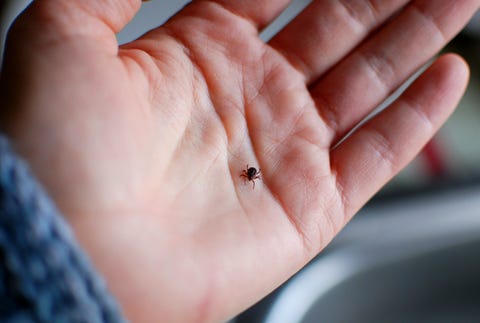The weather is finally nice, but you’re not the only one who wants to come out of hibernation. Ticks are active from April through October, meaning they’re here to potentially ruin all of your outdoor activities.
Data from the Centers for Disease Control and Prevention showed that health departments reported more cases of tick-borne diseases in 2017 than any other year. This uptick is driven by an increase in tick populations, which have multiplied for the past 20 years.
Although ticks can be found in suburbs and cities, they’re prevalent in wooded areas that are damp and have plenty of leaves.
Here’s what you should know about spotting signs of ticks:
Where do ticks hide?
Generally, ticks love areas that retain moisture, says Lyme Disease and tick expert Mark Wooten of the University of Toledo. This means you’ll want to be extra cautious of tall grass, and piles of leaves and wood. Be cautious in areas with large mice populations as ticks feed on the critters. Deer ticks, known for spreading Lyme disease, lurk in trees and shrubs to easily latch onto passing animals. You’ll want to be especially careful when brushing up against trees because ticks grab onto your clothes and hide in the crevices behind your knees or armpits.
What do ticks look like?
Ticks vary in size and color depending on age and species, so there’s not just one characteristic to be aware of. However, ticks could be mistaken for moles when they’ve attached themselves to your skin. You should always inspect your body for ticks after coming inside, and pay particular attention to the back of your knees, armpits, or groin as these areas are popular hiding places. Wooten recommends throwing clothes in the laundry (heat kills ticks) and hopping in the shower after outdoor activities.
What do tick eggs look like?
Nate Nieto, Assistant Professor in the Department of Biological Sciences at Northern Arizona University, says tick eggs look like chicken eggs but more transparent and only half a millimeter in size. They’re laid in large bundles that are reminiscent of a spider’s nest. However, your chances of actually finding tick eggs is extremely rare, says Nieto. Instead, inspect your body for signs of ticks or bites.
What do tick bite look like?
Most people don’t even know if a tick fed on their blood, says Wooten. That’s because ticks have developed pharmacological agents in their saliva that deadens pain.
“These ticks have evolved. They don’t want to harm you. They want you to be healthy,” he says.
Always perform a tick check when you come in from the outdoors. Usually ticks don’t transmit Lyme disease unless they’ve been attached to their host for about two days, meaning you want to spot them immediately, the CDC reports. Keep in mind they are very small and can be mistaken for freckles. Young deer ticks, called nymphs, are responsible for most Lyme Disease cases and are the size of a poppy seed. If possible, enlist a friend or family member to help.
Roughly 70 percent of people who receive a bite from Lyme disease infested ticks may develop a rash. In some cases, the blemish takes the form of a bullseye, so be sure to see your physician if abnormal spots develop.

Judita Juknele / EyeEmGetty Images
What are signs of tick-borne illnesses?
Not everyone will exhibit symptoms, but developing a fever, chills, headache, fatigue and muscle aches could indicate you’ve been attacked by a disease carrying tick.
“You hate being paranoid, but there are a few precautions you can take,” he says. “If you become sick then you should think about it. Is it a summer cold or is there an outside chance that I may have gotten lyme disease?”
Lyme disease symptoms are very similar to the flu and will typically occur before a rash develops. It’s worth going to the doctor if you’ve spent time in tick-prone locations, feel ill, and notice skin abnormalities.
Of course, wearing the right clothes can help you avoid ticks. Experts recommend long sleeve shirts and pants tucked into your socks. Yes, you’ll look dorky but it beats getting a tick bite. Opt for light-colored items so you can easily spot bugs that have latched onto clothes and invest in DEET.
Source: Read Full Article






